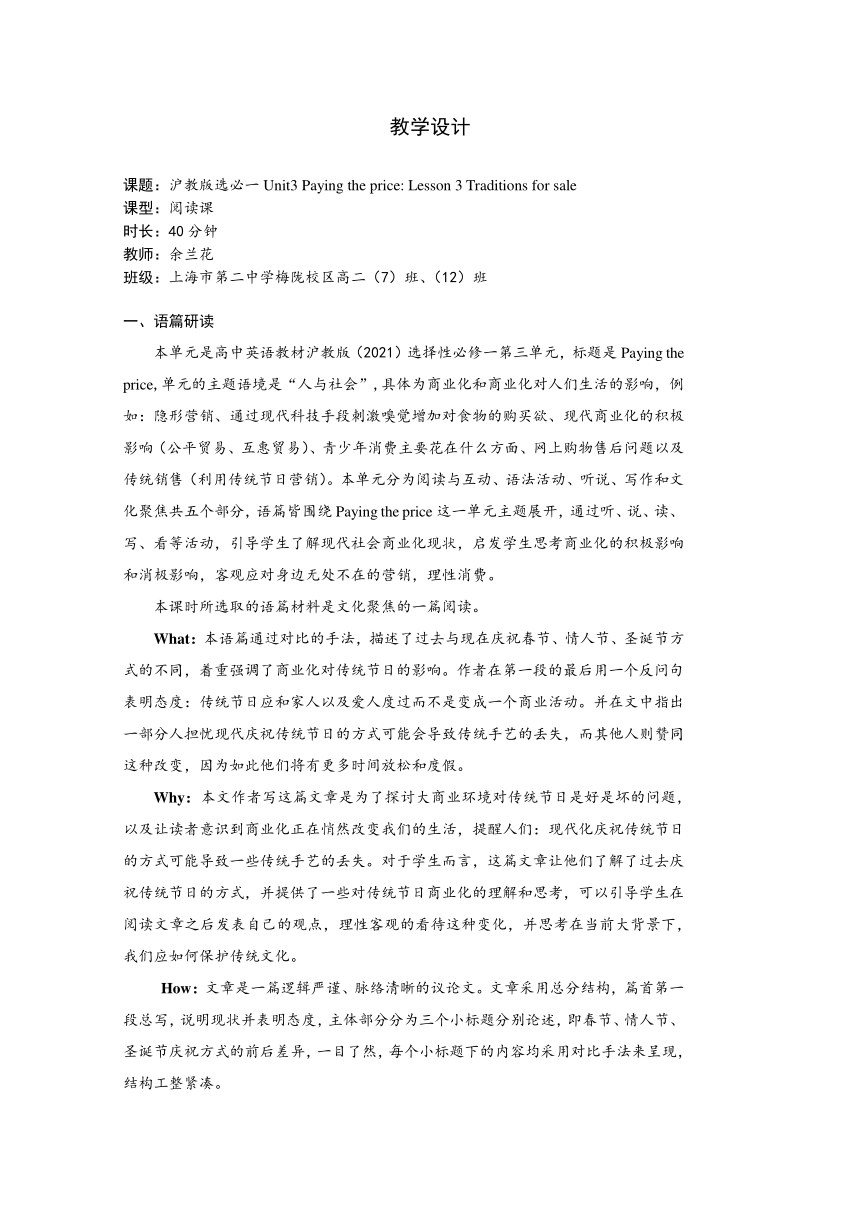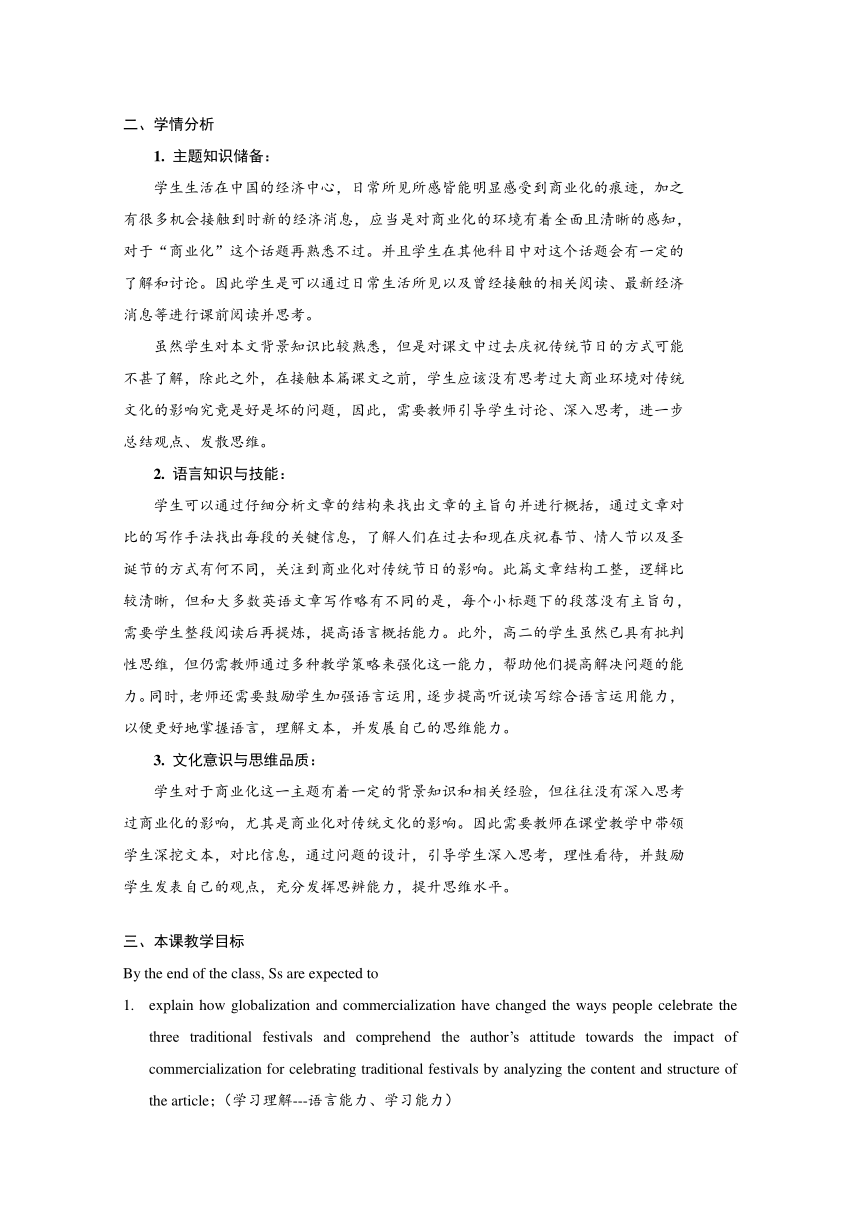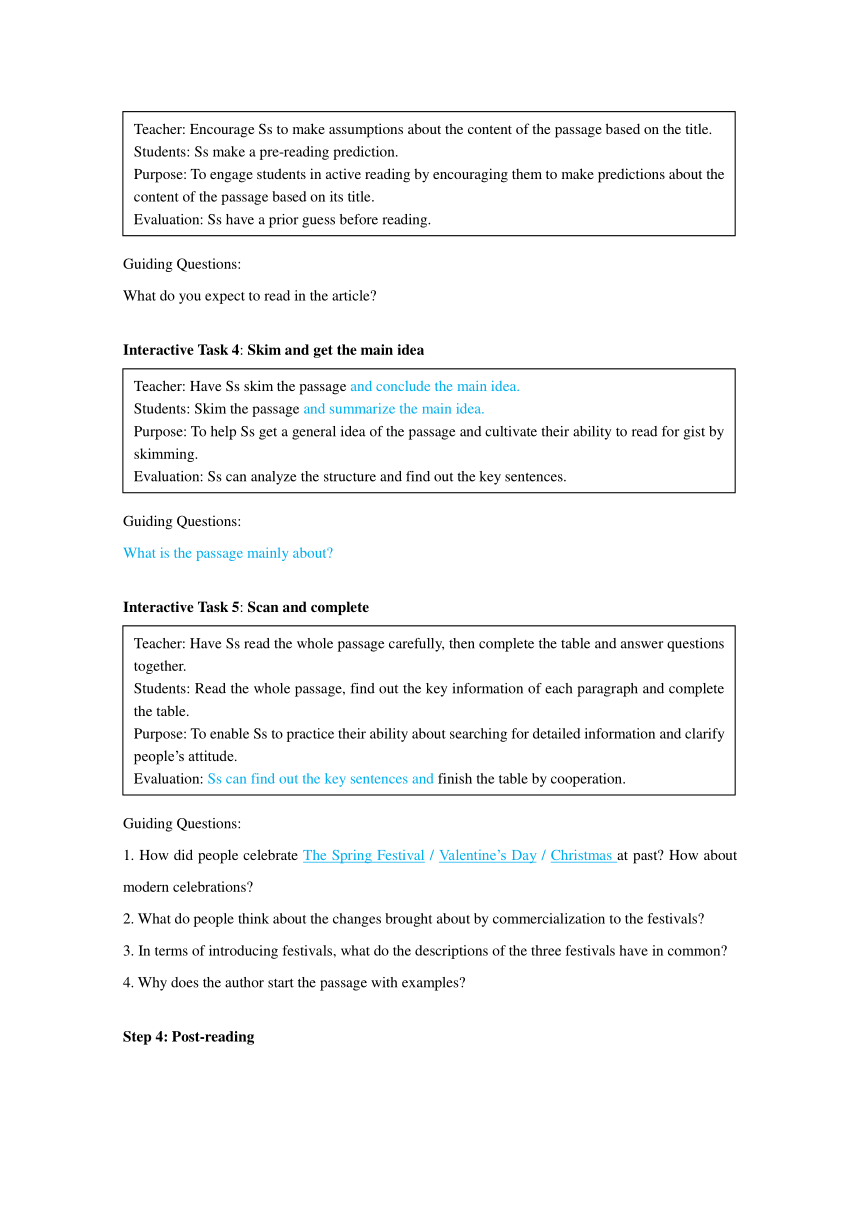Unit 3 Paying the price Culture focus traditions for sale 教学设计-2024-2025学年高中英语沪教版(2020)选择性必修第一册
文档属性
| 名称 | Unit 3 Paying the price Culture focus traditions for sale 教学设计-2024-2025学年高中英语沪教版(2020)选择性必修第一册 |  | |
| 格式 | docx | ||
| 文件大小 | 47.0KB | ||
| 资源类型 | 教案 | ||
| 版本资源 | 上教版(2020) | ||
| 科目 | 英语 | ||
| 更新时间 | 2025-02-25 12:53:20 | ||
图片预览




文档简介
教学设计
课题:沪教版选必一Unit3 Paying the price: Lesson 3 Traditions for sale
课型:阅读课
时长:40分钟
教师:余兰花
班级:上海市第二中学梅陇校区高二(7)班、(12)班
一、语篇研读
本单元是高中英语教材沪教版(2021)选择性必修一第三单元,标题是Paying the price,单元的主题语境是“人与社会”,具体为商业化和商业化对人们生活的影响,例如:隐形营销、通过现代科技手段刺激嗅觉增加对食物的购买欲、现代商业化的积极影响(公平贸易、互惠贸易)、青少年消费主要花在什么方面、网上购物售后问题以及传统销售(利用传统节日营销)。本单元分为阅读与互动、语法活动、听说、写作和文化聚焦共五个部分,语篇皆围绕Paying the price这一单元主题展开,通过听、说、读、写、看等活动,引导学生了解现代社会商业化现状,启发学生思考商业化的积极影响和消极影响,客观应对身边无处不在的营销,理性消费。
本课时所选取的语篇材料是文化聚焦的一篇阅读。
What:本语篇通过对比的手法,描述了过去与现在庆祝春节、情人节、圣诞节方式的不同,着重强调了商业化对传统节日的影响。作者在第一段的最后用一个反问句表明态度:传统节日应和家人以及爱人度过而不是变成一个商业活动。并在文中指出一部分人担忧现代庆祝传统节日的方式可能会导致传统手艺的丢失,而其他人则赞同这种改变,因为如此他们将有更多时间放松和度假。
Why:本文作者写这篇文章是为了探讨大商业环境对传统节日是好是坏的问题,以及让读者意识到商业化正在悄然改变我们的生活,提醒人们:现代化庆祝传统节日的方式可能导致一些传统手艺的丢失。对于学生而言,这篇文章让他们了解了过去庆祝传统节日的方式,并提供了一些对传统节日商业化的理解和思考,可以引导学生在阅读文章之后发表自己的观点,理性客观的看待这种变化,并思考在当前大背景下,我们应如何保护传统文化。
How:文章是一篇逻辑严谨、脉络清晰的议论文。文章采用总分结构,篇首第一段总写,说明现状并表明态度,主体部分分为三个小标题分别论述,即春节、情人节、圣诞节庆祝方式的前后差异,一目了然,每个小标题下的内容均采用对比手法来呈现,结构工整紧凑。
二、学情分析
1. 主题知识储备:
学生生活在中国的经济中心,日常所见所感皆能明显感受到商业化的痕迹,加之有很多机会接触到时新的经济消息,应当是对商业化的环境有着全面且清晰的感知,对于“商业化”这个话题再熟悉不过。并且学生在其他科目中对这个话题会有一定的了解和讨论。因此学生是可以通过日常生活所见以及曾经接触的相关阅读、最新经济消息等进行课前阅读并思考。
虽然学生对本文背景知识比较熟悉,但是对课文中过去庆祝传统节日的方式可能不甚了解,除此之外,在接触本篇课文之前,学生应该没有思考过大商业环境对传统文化的影响究竟是好是坏的问题,因此,需要教师引导学生讨论、深入思考,进一步总结观点、发散思维。
2. 语言知识与技能:
学生可以通过仔细分析文章的结构来找出文章的主旨句并进行概括,通过文章对比的写作手法找出每段的关键信息,了解人们在过去和现在庆祝春节、情人节以及圣诞节的方式有何不同,关注到商业化对传统节日的影响。此篇文章结构工整,逻辑比较清晰,但和大多数英语文章写作略有不同的是,每个小标题下的段落没有主旨句,需要学生整段阅读后再提炼,提高语言概括能力。此外,高二的学生虽然已具有批判性思维,但仍需教师通过多种教学策略来强化这一能力,帮助他们提高解决问题的能力。同时,老师还需要鼓励学生加强语言运用,逐步提高听说读写综合语言运用能力,以便更好地掌握语言,理解文本,并发展自己的思维能力。
3. 文化意识与思维品质:
学生对于商业化这一主题有着一定的背景知识和相关经验,但往往没有深入思考过商业化的影响,尤其是商业化对传统文化的影响。因此需要教师在课堂教学中带领学生深挖文本,对比信息,通过问题的设计,引导学生深入思考,理性看待,并鼓励学生发表自己的观点,充分发挥思辨能力,提升思维水平。
三、本课教学目标
By the end of the class, Ss are expected to
explain how globalization and commercialization have changed the ways people celebrate the three traditional festivals and comprehend the author’s attitude towards the impact of commercialization for celebrating traditional festivals by analyzing the content and structure of the article;(学习理解---语言能力、学习能力)
express their own opinions concerning these changes through in-depth reading and comparison;(应用实践---学习能力,思维品质)
learn to not only cherish and protect traditional festivals, but also cultivate cultural confidence and be willing to spread our traditional festivals. In addition, take a rational view of the impact of commercialization on traditional festivals through combining experience with this passage.(迁移创新---思维品质、文化意识)
四、教学过程(Teaching procedures)
Step 1: Lead-in
Interactive Task 1: Topic-related
Guiding Questions:
What festivals do you celebrate in your family Which is your favorite and why
Step 2: Pre-reading
Interactive Task 2: watch and discussion
Guiding Questions:
1. What do you think of this phenomenon Are you for or against it
2. If you are merchant, do you use traditional festivals as an excuse to spend money Why
Step 3: While-reading
Interactive Task 3: Think and predict
Guiding Questions:
What do you expect to read in the article
Interactive Task 4: Skim and get the main idea
Guiding Questions:
What is the passage mainly about
Interactive Task 5: Scan and complete
Guiding Questions:
1. How did people celebrate The Spring Festival / Valentine’s Day / Christmas at past How about modern celebrations
2. What do people think about the changes brought about by commercialization to the festivals
3. In terms of introducing festivals, what do the descriptions of the three festivals have in common
4. Why does the author start the passage with examples
Step 4: Post-reading
Interactive Task 6: Group discussion
Guiding Questions:
1. Can you think of other changes brought about by commercialization to the Spring Festival What changes
2. Do you prefer the old traditional way to celebrate the Spring Festival or the modern commercialized way Why
Interactive Task 7: reach a conclusion---think and understand
Guiding Questions:
1. How do you understand the title “Traditions for sale”
2. What is the author’s view on the festivals
3. What price are we paying for the commercialized traditions
Assignments
1. Written work (Compulsory---individual work)
Choose your favorite festival and write an essay to introduce: how did your family celebrate it
Word limit: around 120 words.
2. Oral work (Optional---group work)
Surf the Internet in groups of four to collect information of another commercialized festival.
Then prepare a presentation by imitating the “Spring Festival” part or “Christmas” part based on what you have collected and what you have learned in class.
Select one group member to share the presentation in next class.
板书设计:
Traditions for sale
Main idea: Whether big business is good or bad for our traditions.
The changes:
Traditions Modern celebrations
Ways of shopping: traditional markets supermarkets & online
The Spring Festival Time (feast): spent a week /
Place(dinner): at home at a restaurant
/ card
Valentine’s Day: Ways: messages presents
/ dinner
trees goods
Christmas: Evolution: get-togethers global events
Presents shopping
Attitude: bad
Traditions for sale
Driven by profits, big businesses make use of festivals for marketing purposes. Festival are not only cultural symbols, but also commercial events. Nowadays, people use them as an excuse to spend money, but shouldn't our traditional festivals be about spending time with family and loved ones instead
The Spring Festival
It's early February, and Zhang Xiao is packing her suitcase for the Spring Festival. She's not alone; another 400 million Chinese will be on the move during the week-long break. The Lunar New Year is the biggest public holiday in China, with a history stretching back thousands of years. It is celebrated across the world, in cities from New York to London, from Sydney to Vancouver.
The words "Spring Festival" bring to mind a big harmonious family gathered around the dinner table raising a toast to the new year. In the past, families bought ingredients at traditional markets and spent a week preparing the New Year's feast. Nowadays, many people do their grocery shopping in supermarkets or online. It’s also common to have the family reunion dinner at a restaurant rather than at home. Some are worried that old cooking traditions will be lost because of this, but others welcome the change because they now have more time to relax and enjoy the holiday together.
Valentine's Day
Thirty-year-old James has been shopping in Paris. He's had his hair cut, he's bought a card with a heart-shaped design and he's got some chocolates for his girlfriend. Today is 14 February or Valentine's Day—a day when romance and love is celebrated around the world.
Lovers originally celebrated this day by sending romantic messages to each other, but today, sending a card isn't enough. Businesses advertise flowers, perfume, jewellery and romantic dinners for two in the weeks before 14 February, and millions of gifts are produced. James may have only spent 12 euros on his chocolates, but globally, consumers spend 11 million euros every year!
Christmas
On 1 December in Trafalgar Square in London, hundreds of lights on a huge tree are lit. ln high streets and homes across the world, lights on billions of other trees are lit by people too.
Christmas Day is not until 25 December, but in recent years, customers have started to shop weeks in advance. Because of this trend, people in the UK now start thinking of Christmas presents about 11 weeks before the day! Christmas trees decorated for the holiday are typically shown in advertisements. This is because the tree plays an important role in traditional Christmas celebrations: it is the place where the family members gather and where the beautifully wrapped presents are left. Today, big businesses have turned Christmas into a global event, and Christmas products and decorations are made and sold all over the world. Some people think that Christmas has become too commercialized, and that there is too much focus on shopping and advertising. However, people love giving each other presents, no matter what their culture or traditions are.
Worksheet 1
I. Skim the passage and conclude the main idea.
What is the passage mainly about
II. Read the passage and find out the changes brought about by commercialization to each festival. Then complete the table.
Festivals Traditions Modern celebrations
The Spring Festival
Valentine’s Day
Christmas
People’s attitude
Answer questions:
1. In terms of introducing festivals, what do the descriptions of the three festivals have in common
2. Why does the author start the passage with examples
Worksheet 2
I. Group discussion.
1. Can you think of other changes brought about by commercialization to the Spring Festival
2. Do you prefer the old traditional way to celebrate the Spring Festival or the modern commercialized way Why
II. Deeply understand this passage.
1. How do you understand the title “Traditions for sale”
2. What is the author’s view on the festivals
3. What price are we paying for the commercialized traditions
课题:沪教版选必一Unit3 Paying the price: Lesson 3 Traditions for sale
课型:阅读课
时长:40分钟
教师:余兰花
班级:上海市第二中学梅陇校区高二(7)班、(12)班
一、语篇研读
本单元是高中英语教材沪教版(2021)选择性必修一第三单元,标题是Paying the price,单元的主题语境是“人与社会”,具体为商业化和商业化对人们生活的影响,例如:隐形营销、通过现代科技手段刺激嗅觉增加对食物的购买欲、现代商业化的积极影响(公平贸易、互惠贸易)、青少年消费主要花在什么方面、网上购物售后问题以及传统销售(利用传统节日营销)。本单元分为阅读与互动、语法活动、听说、写作和文化聚焦共五个部分,语篇皆围绕Paying the price这一单元主题展开,通过听、说、读、写、看等活动,引导学生了解现代社会商业化现状,启发学生思考商业化的积极影响和消极影响,客观应对身边无处不在的营销,理性消费。
本课时所选取的语篇材料是文化聚焦的一篇阅读。
What:本语篇通过对比的手法,描述了过去与现在庆祝春节、情人节、圣诞节方式的不同,着重强调了商业化对传统节日的影响。作者在第一段的最后用一个反问句表明态度:传统节日应和家人以及爱人度过而不是变成一个商业活动。并在文中指出一部分人担忧现代庆祝传统节日的方式可能会导致传统手艺的丢失,而其他人则赞同这种改变,因为如此他们将有更多时间放松和度假。
Why:本文作者写这篇文章是为了探讨大商业环境对传统节日是好是坏的问题,以及让读者意识到商业化正在悄然改变我们的生活,提醒人们:现代化庆祝传统节日的方式可能导致一些传统手艺的丢失。对于学生而言,这篇文章让他们了解了过去庆祝传统节日的方式,并提供了一些对传统节日商业化的理解和思考,可以引导学生在阅读文章之后发表自己的观点,理性客观的看待这种变化,并思考在当前大背景下,我们应如何保护传统文化。
How:文章是一篇逻辑严谨、脉络清晰的议论文。文章采用总分结构,篇首第一段总写,说明现状并表明态度,主体部分分为三个小标题分别论述,即春节、情人节、圣诞节庆祝方式的前后差异,一目了然,每个小标题下的内容均采用对比手法来呈现,结构工整紧凑。
二、学情分析
1. 主题知识储备:
学生生活在中国的经济中心,日常所见所感皆能明显感受到商业化的痕迹,加之有很多机会接触到时新的经济消息,应当是对商业化的环境有着全面且清晰的感知,对于“商业化”这个话题再熟悉不过。并且学生在其他科目中对这个话题会有一定的了解和讨论。因此学生是可以通过日常生活所见以及曾经接触的相关阅读、最新经济消息等进行课前阅读并思考。
虽然学生对本文背景知识比较熟悉,但是对课文中过去庆祝传统节日的方式可能不甚了解,除此之外,在接触本篇课文之前,学生应该没有思考过大商业环境对传统文化的影响究竟是好是坏的问题,因此,需要教师引导学生讨论、深入思考,进一步总结观点、发散思维。
2. 语言知识与技能:
学生可以通过仔细分析文章的结构来找出文章的主旨句并进行概括,通过文章对比的写作手法找出每段的关键信息,了解人们在过去和现在庆祝春节、情人节以及圣诞节的方式有何不同,关注到商业化对传统节日的影响。此篇文章结构工整,逻辑比较清晰,但和大多数英语文章写作略有不同的是,每个小标题下的段落没有主旨句,需要学生整段阅读后再提炼,提高语言概括能力。此外,高二的学生虽然已具有批判性思维,但仍需教师通过多种教学策略来强化这一能力,帮助他们提高解决问题的能力。同时,老师还需要鼓励学生加强语言运用,逐步提高听说读写综合语言运用能力,以便更好地掌握语言,理解文本,并发展自己的思维能力。
3. 文化意识与思维品质:
学生对于商业化这一主题有着一定的背景知识和相关经验,但往往没有深入思考过商业化的影响,尤其是商业化对传统文化的影响。因此需要教师在课堂教学中带领学生深挖文本,对比信息,通过问题的设计,引导学生深入思考,理性看待,并鼓励学生发表自己的观点,充分发挥思辨能力,提升思维水平。
三、本课教学目标
By the end of the class, Ss are expected to
explain how globalization and commercialization have changed the ways people celebrate the three traditional festivals and comprehend the author’s attitude towards the impact of commercialization for celebrating traditional festivals by analyzing the content and structure of the article;(学习理解---语言能力、学习能力)
express their own opinions concerning these changes through in-depth reading and comparison;(应用实践---学习能力,思维品质)
learn to not only cherish and protect traditional festivals, but also cultivate cultural confidence and be willing to spread our traditional festivals. In addition, take a rational view of the impact of commercialization on traditional festivals through combining experience with this passage.(迁移创新---思维品质、文化意识)
四、教学过程(Teaching procedures)
Step 1: Lead-in
Interactive Task 1: Topic-related
Guiding Questions:
What festivals do you celebrate in your family Which is your favorite and why
Step 2: Pre-reading
Interactive Task 2: watch and discussion
Guiding Questions:
1. What do you think of this phenomenon Are you for or against it
2. If you are merchant, do you use traditional festivals as an excuse to spend money Why
Step 3: While-reading
Interactive Task 3: Think and predict
Guiding Questions:
What do you expect to read in the article
Interactive Task 4: Skim and get the main idea
Guiding Questions:
What is the passage mainly about
Interactive Task 5: Scan and complete
Guiding Questions:
1. How did people celebrate The Spring Festival / Valentine’s Day / Christmas at past How about modern celebrations
2. What do people think about the changes brought about by commercialization to the festivals
3. In terms of introducing festivals, what do the descriptions of the three festivals have in common
4. Why does the author start the passage with examples
Step 4: Post-reading
Interactive Task 6: Group discussion
Guiding Questions:
1. Can you think of other changes brought about by commercialization to the Spring Festival What changes
2. Do you prefer the old traditional way to celebrate the Spring Festival or the modern commercialized way Why
Interactive Task 7: reach a conclusion---think and understand
Guiding Questions:
1. How do you understand the title “Traditions for sale”
2. What is the author’s view on the festivals
3. What price are we paying for the commercialized traditions
Assignments
1. Written work (Compulsory---individual work)
Choose your favorite festival and write an essay to introduce: how did your family celebrate it
Word limit: around 120 words.
2. Oral work (Optional---group work)
Surf the Internet in groups of four to collect information of another commercialized festival.
Then prepare a presentation by imitating the “Spring Festival” part or “Christmas” part based on what you have collected and what you have learned in class.
Select one group member to share the presentation in next class.
板书设计:
Traditions for sale
Main idea: Whether big business is good or bad for our traditions.
The changes:
Traditions Modern celebrations
Ways of shopping: traditional markets supermarkets & online
The Spring Festival Time (feast): spent a week /
Place(dinner): at home at a restaurant
/ card
Valentine’s Day: Ways: messages presents
/ dinner
trees goods
Christmas: Evolution: get-togethers global events
Presents shopping
Attitude: bad
Traditions for sale
Driven by profits, big businesses make use of festivals for marketing purposes. Festival are not only cultural symbols, but also commercial events. Nowadays, people use them as an excuse to spend money, but shouldn't our traditional festivals be about spending time with family and loved ones instead
The Spring Festival
It's early February, and Zhang Xiao is packing her suitcase for the Spring Festival. She's not alone; another 400 million Chinese will be on the move during the week-long break. The Lunar New Year is the biggest public holiday in China, with a history stretching back thousands of years. It is celebrated across the world, in cities from New York to London, from Sydney to Vancouver.
The words "Spring Festival" bring to mind a big harmonious family gathered around the dinner table raising a toast to the new year. In the past, families bought ingredients at traditional markets and spent a week preparing the New Year's feast. Nowadays, many people do their grocery shopping in supermarkets or online. It’s also common to have the family reunion dinner at a restaurant rather than at home. Some are worried that old cooking traditions will be lost because of this, but others welcome the change because they now have more time to relax and enjoy the holiday together.
Valentine's Day
Thirty-year-old James has been shopping in Paris. He's had his hair cut, he's bought a card with a heart-shaped design and he's got some chocolates for his girlfriend. Today is 14 February or Valentine's Day—a day when romance and love is celebrated around the world.
Lovers originally celebrated this day by sending romantic messages to each other, but today, sending a card isn't enough. Businesses advertise flowers, perfume, jewellery and romantic dinners for two in the weeks before 14 February, and millions of gifts are produced. James may have only spent 12 euros on his chocolates, but globally, consumers spend 11 million euros every year!
Christmas
On 1 December in Trafalgar Square in London, hundreds of lights on a huge tree are lit. ln high streets and homes across the world, lights on billions of other trees are lit by people too.
Christmas Day is not until 25 December, but in recent years, customers have started to shop weeks in advance. Because of this trend, people in the UK now start thinking of Christmas presents about 11 weeks before the day! Christmas trees decorated for the holiday are typically shown in advertisements. This is because the tree plays an important role in traditional Christmas celebrations: it is the place where the family members gather and where the beautifully wrapped presents are left. Today, big businesses have turned Christmas into a global event, and Christmas products and decorations are made and sold all over the world. Some people think that Christmas has become too commercialized, and that there is too much focus on shopping and advertising. However, people love giving each other presents, no matter what their culture or traditions are.
Worksheet 1
I. Skim the passage and conclude the main idea.
What is the passage mainly about
II. Read the passage and find out the changes brought about by commercialization to each festival. Then complete the table.
Festivals Traditions Modern celebrations
The Spring Festival
Valentine’s Day
Christmas
People’s attitude
Answer questions:
1. In terms of introducing festivals, what do the descriptions of the three festivals have in common
2. Why does the author start the passage with examples
Worksheet 2
I. Group discussion.
1. Can you think of other changes brought about by commercialization to the Spring Festival
2. Do you prefer the old traditional way to celebrate the Spring Festival or the modern commercialized way Why
II. Deeply understand this passage.
1. How do you understand the title “Traditions for sale”
2. What is the author’s view on the festivals
3. What price are we paying for the commercialized traditions
同课章节目录
